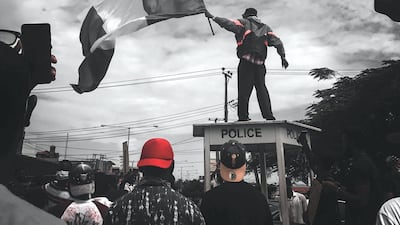On October 1 last year, a young man hoisted a pole bearing the Nigerian flag above his head and set off on a quiet protest.
Flagboy, as he would come to be known by thousands of people, walked the streets of Alausa, Lagos state to draw attention to the EndSARS movement against police brutality.
Nigerians have been demonstrating for the disbanding of the special anti-robbery squad of the Nigerian police force since 2017, but 2020 brought a new vigour to the movement.
In person and online, people came together across Nigeria under the hashtag EndSARS.
But Flagboy’s protest was a solitary one, until a chance encounter changed his life.
“I was moving around with the flag when someone directed me to a protest and told me to go there with it,” said Flagboy, who asked not to be identified for his safety.
“He was a total stranger,” he said, adding that he had no knowledge of the large-scale protest planned in his area.
“I didn't really prepare for the protest. It just happened. I had been carrying my flag before that day, so I carried it to the protest. It was a continued journey for me.”
Almost immediately after Flagboy arrived at the march on October 10, his giant flag began to attract attention.
Seeing him action, the organisers designated him flag-bearer.
“The flag was what everybody followed, so my duty was to stir up the flag in the direction we were going,” he said.
“So, if I leave a location and go to another, everyone follows.”
It was in this new role that Flagboy climbed up onto a police booth to wave his flag with audacity.
At that moment, Ayodeji Adegoroye took the photo that would go on to become a symbol of EndSARS for many Nigerians.
"I was intrigued at first when I saw him," Ms Adegoroye, a photography enthusiast, said.
"And then he climbed the police stand, and I thought I should take a picture. I was not very tall, and so I had to move forward to capture the flag flying properly.”
Ms Adegoroye’s photo of Flagboy exploded on social media after some public figures reposted it.
As the image took on a life of its own, being shared on WhatsApp, Twitter and Facebook, some questioned whether Ms Adegoroye should have demanded credit.
"But that was not why I did it. I took that picture as a reminder that we did something and that I was a part of it,” she said.
“It made me very happy that it was something I did so many people referred to."
Flagboy had no idea his photo had gone viral as he was not actively using social media at the time.
But his image and the voices of others encouraged more and more young people across the country to assemble every day.
The street protests continued until October 20, 2020 – the day of what became known as the Lekki Massacre. Amnesty International said at least 12 protesters were killed and hundreds injured when armed men opened fire on peaceful protesters gathered at a toll gate in the Lekki district of Lagos.
Nigerian security forces deny involvement in the incident, which drew condemnation from around the world, and the Lagos state government has set up a panel to investigate.
The protests moved online after the shooting, and as protesters who were arrested languished in jail without charge or had their bank accounts frozen.
But there is one citizen who takes to the streets of Lagos every day, despite the risks. Flagboy.
He is grossly unsatisfied.
“The killing of the protesters was even more serious than what was happening before. We were protesting for them to end SARS and review their budget and stop corruption and what they did in response to that was to kill people.
“Killing people is a more grievous offence than the other ones. So why are we not protesting this?”
He also feels a personal responsibility to the movement after his viral photo encouraged people to join.
"Many people who came out to Lekki, definitely not all of the people who came out, but many, did because they saw my flag. And I'm sure that some of those people are gone now. So, if nobody is protesting for their deaths, I should protest for their deaths."
He continues with his protest despite the concern of friends and family. As long as the flag is still flying, he says, there is hope.

